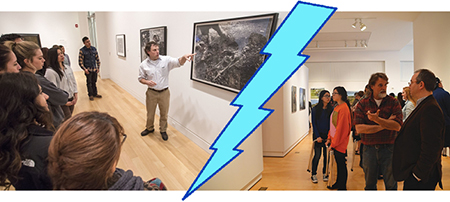
In my professional life April is moving month. I see some of my colleagues shifting jobs from one school to another and some of my former students getting hired for their first crack at teaching this coming Fall. Change is always exciting, and few changes in life are more momentous than a change in location.
Let’s imagine, for example, that there are two 27 year old painters, both pretty fresh out of grad school with a few exhibitions here and there, and both were able to do some part time adjunct teaching. They enjoyed that last bit and are ready for the next step, full-time tenure-track teaching at a university. Let’s assume that this year there are two teaching jobs that stand out for them, and they’re finalists for both — one is at DePaul University, and the other is at DePauw University. These two fine institutions are separated by a great deal more than one letter, and the life of each artist will be significantly impacted by which one he or she ends up joining.
DePaul University is in the middle of the North Side of Chicago and has a student population of about 24,000. Chicago, of course, is one of America’s major cities, with a population in excess of 2.7 million, replete with art museums, art galleries, many other art schools and thousands of artists of every ilk. DePauw University is in Greencastle Indiana and has a student population of about 2,400. Greencastle is a smallish town in west central Indiana, an hour’s drive from Indianapolis, with a population of just over 10,000. There’s a campus gallery, but it’s fair to say that its art community is miniscule in comparison with Chicago’s.
What will be the impact on our two painters if one gets the job at DePaul and the other gets the job at DePauw? What effect might it have on their careers as visual artists? After all, their responsibilities as painting professors won’t be that different at these respective schools. They will serve and function within an academic department and build their case for tenure over six years by being good citizens of their university and establishing their professional status by pursuing options to exhibit their own work locally and perhaps nationally. But let’s be realistic — while both will probably find their teaching duties fulfilling and engaging, and while a painting classroom in Greencastle looks pretty much like a painting classroom in Chicago, the DePaul professor will have a professional advantage over his or her colleague at DePauw.
Because while you can make art anywhere, history teaches us that in the great preponderance of cases, art thrives best in an urban environment. Our DePaul professor will find him- or herself in a dense matrix of art professionals, surrounded by a peer group of hundreds of artists who will be expecting, even demanding, excellence of their new colleague. He or she will be competing not just with colleagues at DePaul but with faculty from dozens of other colleges and art schools, in a situation where it won’t be enough just to be a good teacher and popular professor, but where you had better show professional advancement and a career trajectory as a visual artist that is clearly pointing up. You’ll need to prove all that for tenure at DePaul.
At DePauw? While there will be pressure to be an excellent teacher and colleague and to be diligent about your practice as a painter, the competition you will feel, if you feel it at all, will probably be more internal than external. There won’t be art openings every week in Greencastle, there won’t be the possibility of showing your work to your peers and community at professional art galleries, seen and discussed by professional art writers or curators and the like. Your art world will be decompressed and you won’t be required to prove your worth as an artist at every turn. Who, besides the face in your mirror, will be challenging you to excel in Greencastle?
Let’s face it — where you live for the majority of your adult life is one of the most important decisions you will ever make. Yet a lot of us don’t put much energy into considering where we should live. We return to the place of our birth and upbringing or hang around where we went to college or grad school (that’s what I did), we follow a lover to their community or, as in the case described above, where we get a job. And yet, where you live has extraordinary impact on the person you become; the community, its weather, architecture, local traditions and history, it all inevitably sculpts you a bit. We adapt to our place of residence to make it fit us and ourselves fit it. Place matters, and it will matter for our two painters too. Some will thrive in a less stimulating environment, just as there are hearty species that take strength from difficult terrain and literally couldn’t live in a more fecund zone. But, all in all, the best conditions for survival and growth are in more optimal environments, more things grow in temperate zones than in deserts. DePaul or DePauw — what a difference a letter can make!
